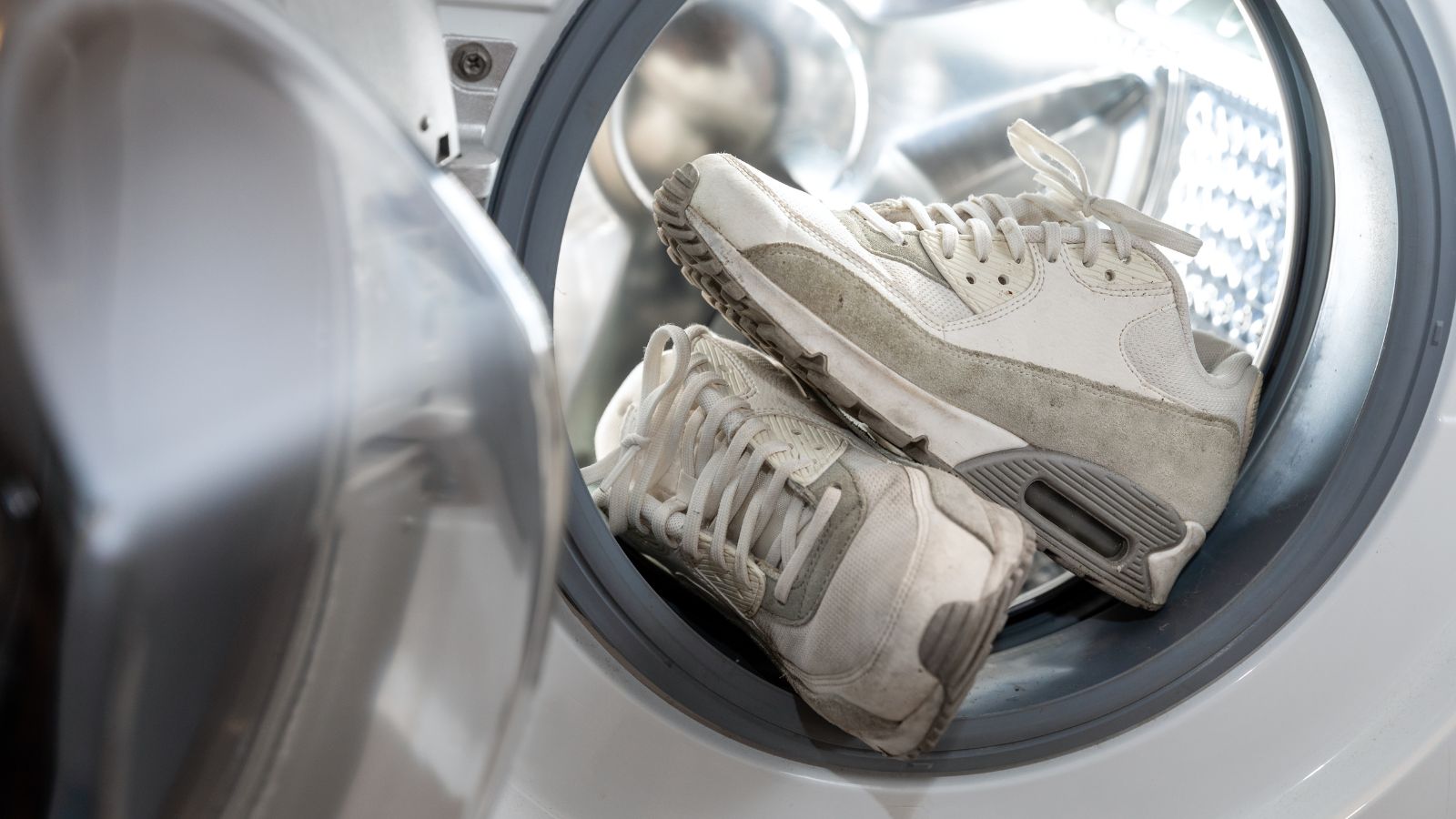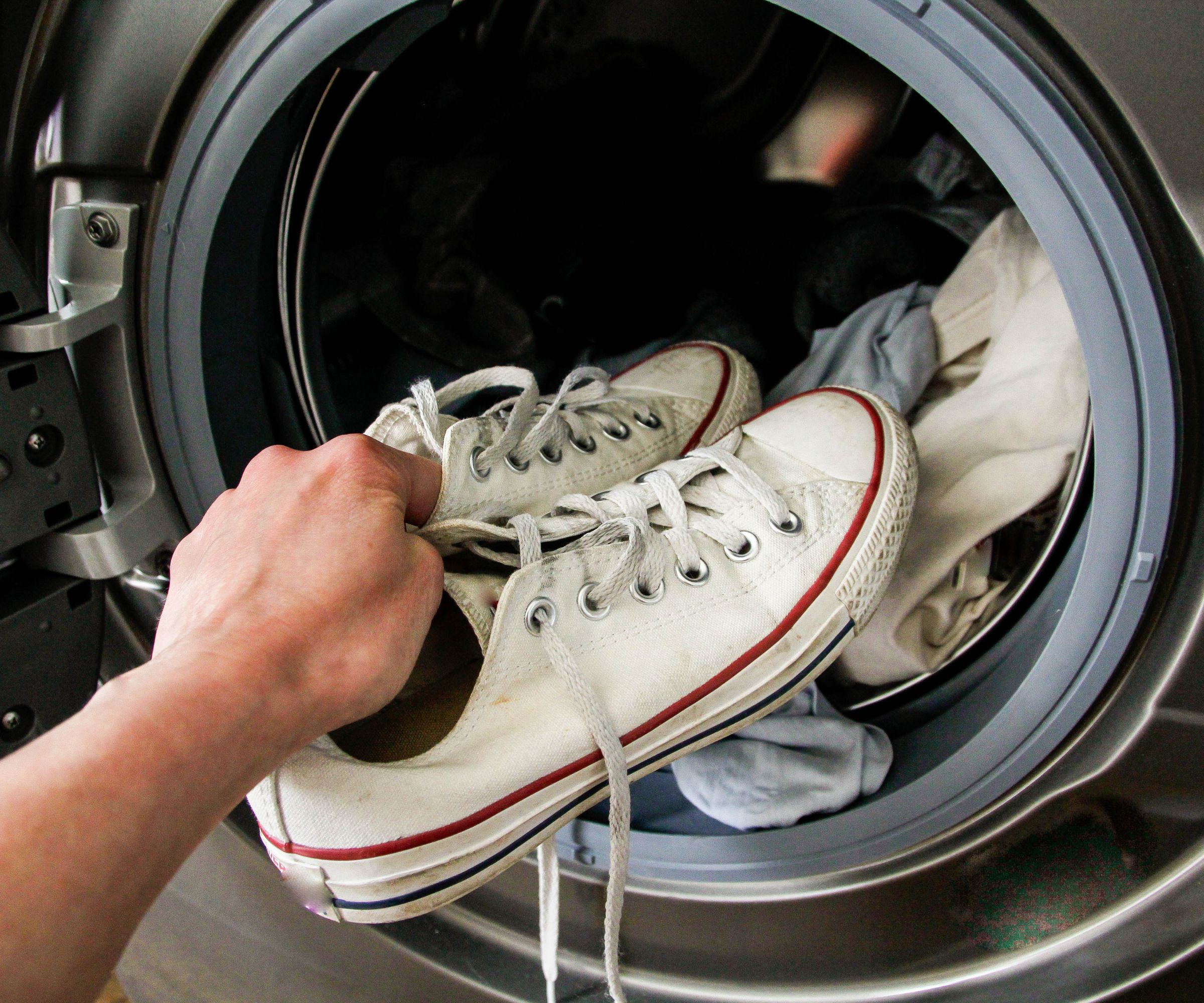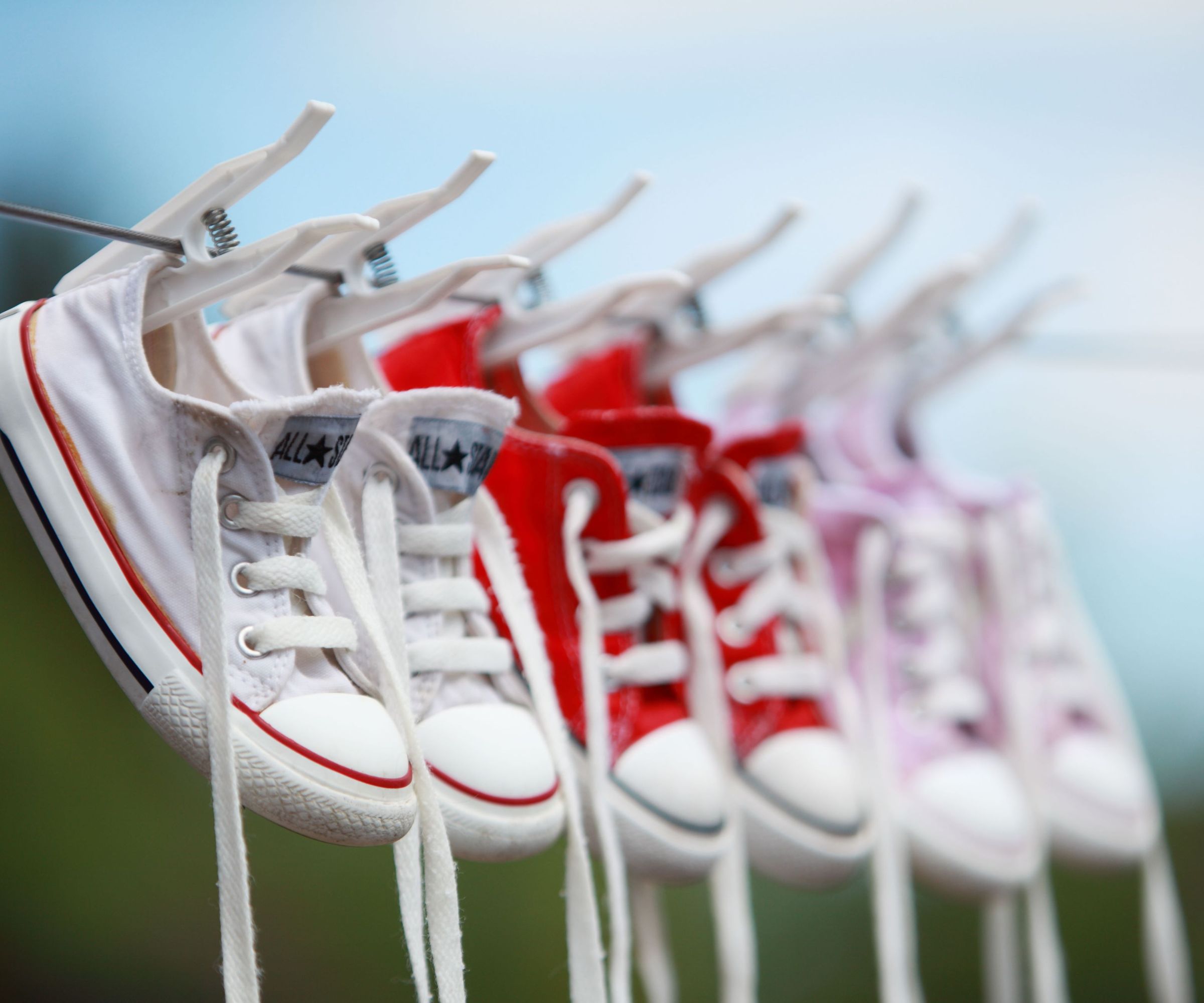How to wash sneakers the right way – and avoid irreversible damage
Washing sneakers isn't always straightforward – here's how to get it right

Aimen Rehman

Sneakers are by far some of the most comfortable and versatile shoes in our closets, but with heavy wear comes heavy soiling.
However, unlike quickly wiping leather shoes, or throwing canvas into the washing machine, the range of materials on sneakers makes them a little more tedious to clean and dry without accidentally damaging them, or leaving stains behind.
We chatted with shoe and cleaning experts to learn more about how to wash sneakers and the right way to restore our shoes to as good as new with and without a washing machine.
How to wash sneakers the right way
How you wash sneakers will largely depend on the materials used to make them. While some sneakers are safe to put in the washing machine, sneakers with leather components are better hand-washed.
With that in mind, here is how to wash sneakers both ways without incurring damage.
How to wash sneakers in the washing machine

You will need:
- Liquid laundry detergent
- Mesh laundry bags
- Old towels or linens
- An old, clean toothbrush or other soft bristled brush
- A damp cloth
- Optional: A disinfectant and white vinegar
1. Wipe off as much mud as you can
Before plunging your dirty sneakers in the washing machine, make sure to remove any dirt and anything stuck to the soles first with a soft brush and then a damp cloth. This is to ensure that any unnecessary dirt or gravel doesn’t enter the washing machine.
With the loose debris removed, you should also spot-treat any obvious stains to make your washing machine's job easier.
Design expertise in your inbox – from inspiring decorating ideas and beautiful celebrity homes to practical gardening advice and shopping round-ups.
'Prioritise spot cleaning to target stains and spills, reducing frequent wash cycles and extending your item's lifespan,' say the garment experts at Superdry. ' Match the solution to the problem – using the right product for both the type of fabric and the type of stain will help you get the best results. And always follow the instructions and test on a small, out-of-the-way area first to check there’s no unintended color change or damage.'
2. Take out the insoles and laces
'Remove the laces and insoles and simply toss them in a mesh laundry bag so they don't get tangled up in the wash,' suggests Natasha Sweet, product specialist at AEG.
Your laces should be soaked separately in a solution of Oxi Clean White Reviver, at Walmart, or put in a wash that matches your lace color – using a mesh laundry bag, also from Walmart, to keep them together and untangled, and protect your washing machine.
3. Pad out the washing machine
Putting sneakers in the washing machine on their own will not only be incredibly loud but risk damaging both your shoes and your drum. To help dampen sound and avoid damage, consider padding out your washing machine with old towels or linens to provide some cushioning,' Natasha Sweet adds. This also helps to balance the load so that your washing machine is not damaged.
It is also helpful to put the sneakers in either a mesh bag or an old pillowcase to help keep them together and prevent further damage, Natasha continues.
4. Wash sneakers in cold water
While it might be tempting to put sneakers on a hot wash, using cold water for the wash, or at least on the coolest setting, will ensure their colors don’t fade and that they don't shrink.
Many newer washing machines come with a built-in mode specifically for washing shoes. If yours has this, make sure to select this appropriate washing option. if not, a gentle cycle with a slow spin speed is your next best option.
Consider using a liquid detergent rather than powder, as the liquid will dissolve more easily, while powder can get stuck in the crevices of the shoes. You can also add vinegar to laundry when washing shoes to help get mold off shoes and combat lingering odors to make laundry smell better.
If you struggle with fungal foot conditions or hyperhidrosis, you might also want to add a disinfectant detergent to the cycle to help combat further flare-ups and remove lingering bacteria.
How to wash sneakers by hand

If your sneakers have leather or suede parts, or you are concerned about damaging your shoes or your machine, it's much safer to hand wash them.
You will need:
- A clean cloth
- An old, clean toothbrush
- Liquid laundry detergent
- Baking soda or a dedicated stain remover
- Optional: A suede brush
- Optional: Leather polish
1. Remove laces, wipe off mud
Just as you would prepare sneakers to be washed in a washing machine, always start the cleaning process by removing the insoles and laces to pull out the tongue, and brushing off loose dirt and debris with a soft-bristled brush and a damp cleaning cloth.
This will make scrubbing away stains and dirt easier.
2. Spot clean stains
Before you wash the whole shoe, it is a good idea to complete any dedicated stain treatments.
'For areas that have seen more damage, grab your baking soda from the kitchen and mix one to two tablespoons with enough warm water to create a paste consistency,' recommends Luke Goodyear, head of operations at shoe cleaning and restoration service, Shoe Lab for Sports Direct. 'Once the paste is ready, apply to a cloth and gently rub over the affected area. You might need to let it sit for 10-20 minutes to help lighten stains.
'Once you’re happy with the surface, use a damp cloth to go over the area and remove any excess paste.'
3. Gently brush and wipe the outside of sneakers
If you are hand-cleaning sneakers, it is likely due to delicate materials such as leather and suede components. As such, it is important to proceed with caution.
- Cleaning rubber and synthetics: Now put liquid detergent into warm water and use the solution to work at the synthetic parts of the sneakers with a soft brush – a toothbrush and soft cloth will do. Start on the least dirty areas of the sneakers before moving to the muddiest parts. Rinse the sneakers and repeat with clean water and more detergent as needed. Really stubborn stains can be worked on with Vanish Oxi Action Gel, from Amazon, then rinsed again. Mr Clean Magic Erasers, also at Amazon can be used to remove scuffs on the rubber parts of the sneakers.
- Cleaning leather: For the leather areas of the sneakers, avoid getting them too wet. You can do this by swapping the brush for the soft cloth alone – a microfiber cloth is ideal, but ensure you constantly refresh the warm water/non-biological detergent mix so that you are not working dirty water into the leather. You can finish up with a leather polish to moisturize the material and prevent cracking.
- Cleaning suede: 'If your shoes are made with suede, these need to be kept away from water. A suede brush is the best way to clean suede sneakers,' says Sarah Dempsey, cleaning expert. 'This is a type of brush with very gentle bristles that help to remove dirt, scuff marks, and water spots without compromising the shoe. Gently brush your suede shoes with the suede brush in different directions until the stain is removed. Once you’ve finished cleaning the shoe, you will then need to brush all of the suede in one direction to help preserve the nap of the material.'
- Cleaning Velcro: Tackling velcro? 'Velcro fastenings can become gathered with dust, hair, string, grass, and other fiddly items,' says Luke Goodyear. 'One way to remove these is to grab your tweezers and pick out the obvious pieces of dirt, before using a comb or old toothbrush to remove any further dust or debris. Alternatively, use a small wire brush to rub dirt away from velcro.'
4. Clean the inside of the sneakers
'A lot of people tend to focus on the overall appearance of shoes and forget to clean the inside, which is crazy,' says Luke Goodyear.
'One way to tackle this is to apply a mild soap, such as washing up liquid, or detergent to a damp cloth and work it into the inner shoe. It’s important not to saturate the shoe when doing this, so make sure to ring out the cloth fully before starting and air dry the shoes for at least 24 hours before re-wearing.'
How to dry sneakers

When it comes to drying your sneakers, 'step away from the tumble dryer!' Natasha Sweet urges. 'The heat can warp and damage your beloved trainers.' Instead, you should consider air drying.
If you need to dry sneakers quickly, 'stuff your trainers with paper towels or a clean cloth to help them keep their shape and absorb excess moisture,' Natasha suggests. Then, place them in a well-ventilated, warm area, such as close to (but not on top of) a heat vent. It is also helpful to use a dehumidifier to help draw excess moisture away and circulate dry air.
Unless your sneakers are white, drying in the sunlight could risk fading bright colors, Natasha mentions. You can dry your sneakers outdoors but do so away from direct sunlight, otherwise any colored parts may fade.
Placing white sneakers in the sun, however, can help to brighten the fabric and keep them looking fresh. Be sure that they do not get too hot, however, as it risks damaging the rubber and adhesive.
FAQs
How often should you wash sneakers?
It is a good rule of thumb to lightly wash sneakers every two weeks, brushing loose dirt away from the exterior and freshening up the interior to prevent stains and odors. You should then deep clean sneakers every few months, or whenever they are heavily soiled, to keep them looking their best.
How do you remove odor from sneakers?
One of the best ways to remove odors from shoes is to spray them with equal parts white vinegar and water. Spray the interior of the shoe liberally and leave open to dry, preferably outside where fresh air can circulate. If the odor remains, consider deep cleaning your sneakers to kill bacteria.
Before washing sneakers, it is always advised to check the laundry symbols on the care label for any distinct and specialized cleaning instructions. This will indicate whether or not the sneaker is safe for the washing machine, and which types of product to use to avoid damage.

Chiana has been at Homes & Gardens for two years and is our resident 'queen' of non-toxic living. She spends most of her time producing content for the Solved section of the website, helping readers get the most out of their homes through clever decluttering, cleaning, and tidying tips. She was named one of Fixr's top home improvement journalists in 2024.
- Aimen RehmanContributing Editor